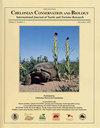西澳大利亚Gnaraloo湾的海龟栖息地:使用夜间观测来验证昼夜轨迹解释
IF 0.8
4区 生物学
Q3 ZOOLOGY
引用次数: 1
摘要
我们对偏远或欠发达地区许多海龟筑巢聚集的了解仍然存在重大差距。在这里,我们总结了前8年在西澳大利亚Gnaraloo湾的系统监测。在2008/09至2015/16年的筑巢季节,我们每天在这个约7公里的大陆海滩进行日间径迹调查。每个季节记录的总出巢数(即巢数和筑巢失败数)为480 ~ 813只(平均= 679.0,SE = 49.1),巢数为305 ~ 522只(平均= 376.0,SE = 26.7)。筑巢活动的高峰发生在12月中旬至1月下旬,在此期间平均每周约有70只出现和35个鸟巢。大多数(97%)的出现和巢来自红海龟(Caretta Caretta),其余(3%)来自绿海龟(Chelonia mydas)。在研究过程中,每个季节记录的红海龟出现的数量显著下降,而巢的数量却没有下降,尽管我们怀疑巢探测错误导致了趋势之间的差异。我们在2010/11至2015/16季节的部分时间进行了夜间调查(即直接观测),以验证日轨迹解释并评估日数据集中的潜在偏差。除1个季节外,红海龟日巢数均被低估,平均巢检测偏差为- 13.0% (SE = 3.0)。在考虑到这种偏差后,我们估计每年在Gnaraloo湾调查区域,85只雌性红海龟大约挖出405个巢穴。同样位于Gnaraloo海岸的法夸尔角调查区也出现了类似或略低数量的红海龟筑巢活动;因此,该地区包含了以前未被报道的该物种的筑巢聚集。Gnaraloo栖息地可能在东南印度洋红海龟亚种群的动态中发挥重要作用,但由于历史上引入的狐狸的捕食,相对于历史水平,Gnaraloo栖息地可能仍然处于枯竭状态。因此,在这个关键时刻,监测、研究和保护Gnaraloo海滩至关重要。本文章由计算机程序翻译,如有差异,请以英文原文为准。
The Sea Turtle Rookery at Gnaraloo Bay, Western Australia: Using Nocturnal Observations to Validate Diurnal Track Interpretations
Abstract Critical gaps remain in our understanding of many sea turtle nesting aggregations in remote or undeveloped regions. Here, we summarize the first 8 yrs of systematic monitoring of the rookery at Gnaraloo Bay, Western Australia. Diurnal track surveys on this approximately 7-km mainland beach were conducted daily during nesting seasons 2008/09 to 2015/16. The total number of emergences (i.e., nests and failed nesting attempts) recorded per season ranged from 480 to 813 (mean = 679.0, SE = 49.1), whereas the number of nests ranged from 305 to 522 (mean = 376.0, SE = 26.7). Peak nesting activity occurred between mid-December and late January, with approximately 70 emergences and 35 nests recorded on average per week during this time. The majority (97%) of emergences and nests were from loggerhead turtles (Caretta caretta), whereas the remainder (3%) were from green turtles (Chelonia mydas). The number of loggerhead turtle emergences recorded per season declined significantly over the course of the study, wheras the number of nests did not, although we suspect that nest detection errors contributed to the difference between trends. We conducted nocturnal surveys (i.e., direct observations) during parts of seasons 2010/11 to 2015/16 to validate diurnal track interpretations and assess potential biases in the diurnal data set. Diurnal nest counts for loggerhead turtles were underestimates in all seasons but one, with an average nest detection bias of −13.0% (SE = 3.0). After accounting for this bias, we estimate that approximately 405 nests are dug by 85 female loggerhead turtles in the Gnaraloo Bay survey area annually. A similar or slightly lower amount of loggerhead turtle nesting activity occurs at the Cape Farquhar survey area, also located on the Gnaraloo coast; thus, this region contains previously underreported nesting aggregations of this species. The Gnaraloo rookeries may play an important role in the dynamics of the southeast Indian Ocean loggerhead turtle subpopulation and may still be depleted relative to historic levels due to historical predation by introduced foxes. Monitoring, research, and the protection of Gnaraloo beaches are, therefore, critical at this juncture.
求助全文
通过发布文献求助,成功后即可免费获取论文全文。
去求助
来源期刊
CiteScore
1.70
自引率
14.30%
发文量
17
审稿时长
>12 weeks
期刊介绍:
Chelonian Conservation and Biology is a biannual peer-reviewed journal of cosmopolitan and broad-based coverage of all aspects of conservation and biology of all chelonians, including freshwater turtles, marine turtles, and tortoises. Manuscripts may cover any aspects of turtle and tortoise research, with a preference for conservation or biology. Manuscripts dealing with conservation biology, systematic relationships, chelonian diversity, geographic distribution, natural history, ecology, reproduction, morphology and natural variation, population status, husbandry, community conservation initiatives, and human exploitation or conservation management issues are of special interest.

 求助内容:
求助内容: 应助结果提醒方式:
应助结果提醒方式:


